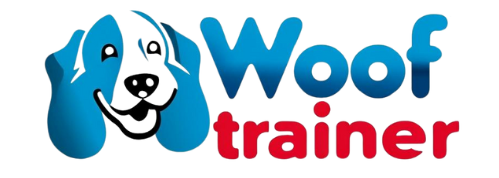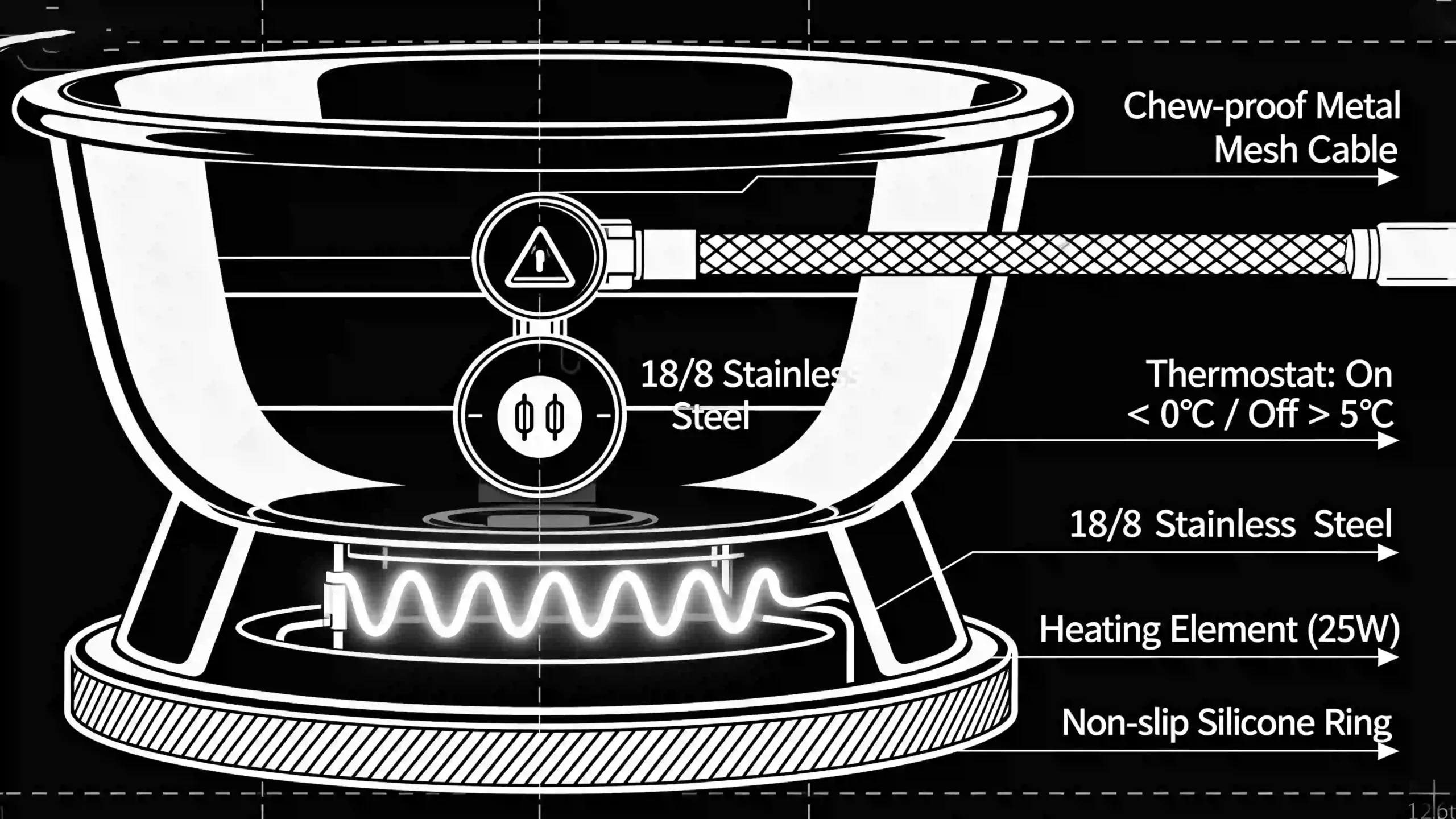Suburban dog owners in cold climates know the frustration of arriving outside to find their dog’s water frozen solid. For Huskies, Labradors, Shepherds, or any breed used to colder weather, staying hydrated is essential. Heated dog bowls offer a solution—but how heated dog bowls work is more than just “plug it in.” This article explains the science, safety, and design features behind freeze-proof technology, pet bowl electricity concerns, and what makes a safe dog bowl for winter use.
Basic Principles: Heat + Thermostat + Material
To prevent ice building up, a heated bowl must supply enough warmth to counteract freezing, but without making the water too hot or unsafe. Key elements include:
- Heating element: Usually under the base of the bowl (or embedded in its bottom). It provides heat via a resistive element powered by electricity.
- Thermostatic control: A thermostat senses temperature; when water or ambient temperature drops near freezing (0 °C / 32 °F), the heater activates; when water gets warm (say above ~5-10 °C depending on the model), the heater shuts off. This reduces energy waste and prevents overheating. Many high-quality models are designed to heat only when necessary.
- Insulation and material: Materials like stainless steel conduct heat well but also radiate/lose heat if poorly insulated; heavy-duty plastic may insulate but lose durability. The design (e.g. thickness of bowl walls, base insulation, wind exposure) plays a big role in preventing ice build-up.
Freeze-Proof Technology: What Actually Prevents Ice
When “freeze-proof” is claimed, what features are usually involved?
- Continuous low-level heating: The heater doesn’t aim to boil or even warm water to high temps; it aims to keep water above freezing. A differential (hysteresis) thermostat helps—once water is above a threshold, heater cycles off, reducing energy use.
- Sealed, waterproof components: Electrical parts are sealed so water splashes, snow, or ice aren’t able to reach live parts.
- Chew-resistant cord and low voltage where possible: Because dogs often chew cords or tug on them. Use of wire-wrapped or metallic jackets around cords helps. Also, using low-voltage supplies (e.g. 24V vs mains 120/230V) reduces risk.
- Base design to avoid exposed wires or elements: Flat bottoms, rubber rings to stabilize, avoiding exposed screws or elements that can catch ice or snow.
Meet Wooftrainer heated dog bowl: it is built to heavy-duty specs: made of food-grade 18/8 stainless steel, size 30 cm diameter × 10 cm high for good water volume; it uses a 24V low-voltage supply, avoiding much of electrical shock risk. Its 50W heating element keeps water between 0 °C–20 °C even when ambient falls to −20 °C. The cord is a chew-resistant stainless steel wrap, and base has a rubber ring to prevent tipping. This combination of insulation, proper materials, and safety features is exactly what science suggests for effective freeze-proof tech.
Electricity & Energy Considerations
One worry many suburban owners have: how much does a heated bowl cost to run? Key points:
- Wattage vs usage time: A bowl may be rated 50-W or 60-W, but it doesn’t run at full power continuously—thermostat cycles it on only when needed. In moderate cold, heater might run for short bursts; in deep freeze, more often.
- Voltage and safety: Models using lower voltage (like 24V) are safer around wet environments and for dogs chewing or pushing on cords. High-voltage models need better insulation, more robust cords, and GFCI outlets.
- Trade-offs with insulation: Better insulation or thicker walls reduce heat loss, so the heater runs less often, saving energy. A well-designed bowl may cost significantly less than one with poor heat retention.
Safety Aspects and Material Choices
Science doesn’t just cover preventing freezing—it also covers preventing hazards:
- Food-grade materials: Stainless steel (especially 18/8, aka 304 alloy) is non -porous, easy to clean, resists rust and corrosion. Plastic must be BPA-free, rated for outdoor use, UV resistant.
- Cord protection: A chew-resistant wrap, positioning cord off the ground, or covering it helps avoid chewing, moisture exposure, and wear.
- Avoid running dry: If water level becomes too low, the heating element can overheat, burn out, or (in some designs) become a hazard. Keeping water at a minimum level is essential.
- Placement matters: Putting the bowl in a sheltered area (under a porch overhang, in a shed) reduces wind chill and snow buildup. Elevating off direct snow or ice helps too.
Concerns like Why Your Dog Refuses to Drink from Frozen Water Bowls often stem from water being too cold or forming a thin film of ice—even small freezing reduces water palatability. Heated bowls maintain drinkable temperature zone, making pets more willing to drink.
Real-World Use: Matching Science to Lifestyle
For suburban dog owners with large breeds in cold winters, practical implementation includes:
- Choosing a bowl with enough volume so that water doesn’t freeze from the top layer too fast. A bowl that is too shallow loses heat quickly.
- Ensuring the heater is powerful enough: e.g. ~50-60 W is often reasonable for a single large dog in –10 to –20 °C weather, provided insulation and placement are good.
- Regular checks to ensure heater is functioning, water isn’t dirty or contaminated, cord is intact.
- Considering mixed setups: perhaps a heated bowl near the house and another in the yard, so dogs always have access even if one fails or is in shade.
Also, examining time savings: many owners notice that heated bowls save them frequent trips to break ice, especially overnight. That links to topic Do Heated Dog Bowls Really Save You Time in Winter, which shows the qualitative benefit beyond electricity cost.
Summary
Putting it all together:
- They prevent ice via continuous (or thermostatically cycled) heating that keeps water above freezing point.
- Material and design (insulation, stainless steel vs plastic, cord protection, low voltage) determine how efficient, safe, and durable they are.
- For the target audience—large breeds in harsh winters—a good freeze-proof bowl offers peace of mind: less manual labor, more consistent hydration, and lower risk of injury from slippery ice or dehydration.
FAQ
-
What temperature do heated dog bowls usually maintain?
Many well-designed bowls keep water between about 0 °C and ~20 °C, depending on ambient temperature. The goal is to stay just above freezing, perhaps a few degrees higher, so water remains liquid but not scalding. In very cold weather they may hover near freezing if heater is powerful and well insulated. -
Is using a heated bowl safe for electricity and pets?
Yes—if certain standards are met: low-voltage or properly insulated high-voltage, sealed heating elements, chew-resistant cord wrap, outdoor-rated plugs and outlets (GFCI where required), non-toxic materials. Brands that emphasize safety features are preferable. -
Does more wattage always mean less freezing?
Not necessarily. While higher wattage allows faster recovery of heat after large heat loss (e.g. wind, snow on surface), without proper insulation, placement, and design, much of that power can be wasted. A well-insulated, moderately powered bowl often outperforms a poorly built high-wattage one. -
How much does power cost in winter for a heated dog bowl?
It depends on local electricity rates, wattage, and how often heater runs. As an estimate: a 50-W bowl running half the time equals ~600 Wh (0.6 kWh) over 24 hours; at US average ~$0.13/kWh, that’s around $0.08 per day. Deep cold may increase usage. Keeping insulation and minimizing heat loss helps reduce the cost. -
Can a heated bowl completely eliminate ice build-up?
Not always. In extreme conditions with wind, snow, or after power failures, ice can still form. But a properly built and maintained heated bowl (good thermostat, correct wattage, protected location) drastically reduces ice formation compared to unheated bowls. It rarely eliminates every risk, but greatly improves reliability.


